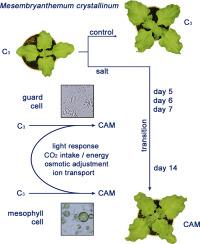Journal of Proteomics ( IF 2.8 ) Pub Date : 2020-10-16 , DOI: 10.1016/j.jprot.2020.104019 Qijie Guan 1 , Wenwen Kong 2 , Dan Zhu 3 , Wei Zhu 1 , Craig Dufresne 4 , Jingkui Tian 5 , Sixue Chen 6

|
Salinity can induce Mesembryanthemum crystallinum to shift its photosynthesis from C3 to crassulacean acid metabolism (CAM), leading to enhanced plant water use efficiency. Studying how M. crystallinum changes its carbon fixation pathways is important for potential translation into crops and enhancing crop resilience. In this study, we examined proteomic changes in guard cells and mesophyll cells in the course of the C3 to CAM transition. We collected enriched guard cells and mesophyll cells during a short period of transition. A total of 1153 proteins were identified and quantified in the two cell-types. During the transition, proteins in the guard cells and mesophyll cells exhibited differential changes. For example, we observed nocturnal carbon fixation in mesophyll cells and proteins involved in cell growth in the two cell-types. Proteins involved in osmotic adjustment, ion transport, energy metabolism and light response may play important roles in the C3 to CAM transition. Real-time PCR experiments were conducted to determine potential correlations between transcript and protein levels. These results have highlighted potential molecular mechanisms underlying the C3 to CAM transition of guard cells and mesophyll cells of the important facultative CAM plant.
Biological significance
Fresh water resource for agricultural food production is a global challenge. Nature has evolved crassulacean acid metabolism (CAM) plants with enhanced water use efficiency. Using single cell-type proteomics, this study revealed molecular changes taking place in guard cells and mesophyll cells during the shift of ice plant photosynthesis from C3 to CAM. The results have provided important insights into the CAM transition and may facilitate effort toward enhancing crop resilience for global food security.
中文翻译:

的比较蛋白质组学冰叶日中花保卫细胞和叶肉细胞中过渡选自C 3至CAM
盐度可以诱导结晶菊花将其光合作用从C 3转变为十字绣果酸代谢(CAM),从而提高植物的水分利用效率。研究结晶分支杆菌如何改变其碳固定路径对于潜在转化为农作物和增强农作物的抗逆性很重要。在这项研究中,我们研究了C 3过程中保卫细胞和叶肉细胞的蛋白质组变化到CAM过渡。我们在短暂的过渡期内收集了丰富的保卫细胞和叶肉细胞。在两种细胞类型中共鉴定并定量了1153种蛋白质。在过渡过程中,保卫细胞和叶肉细胞中的蛋白质表现出差异变化。例如,我们在两种细胞类型的叶肉细胞和参与细胞生长的蛋白质中观察到夜间碳固定。参与渗透调节,离子迁移,能量代谢和光反应的蛋白质可能在C 3向CAM的转变中起重要作用。进行实时PCR实验以确定转录本和蛋白质水平之间的潜在相关性。这些结果凸显了C 3潜在的分子机制 重要的兼性CAM植物的保卫细胞和叶肉细胞向CAM的转化。
生物学意义
用于农业食品生产的淡水资源是一项全球挑战。大自然已经进化出水杨酸代谢(CAM)植物,从而提高了水分利用效率。使用单细胞型蛋白质组学,这项研究揭示了在冰植物光合作用从C3转变为CAM的过程中,保卫细胞和叶肉细胞发生了分子变化。结果为CAM过渡提供了重要见解,并可能有助于增强作物抗逆能力以实现全球粮食安全的努力。











































 京公网安备 11010802027423号
京公网安备 11010802027423号